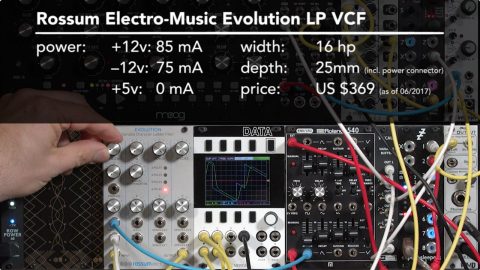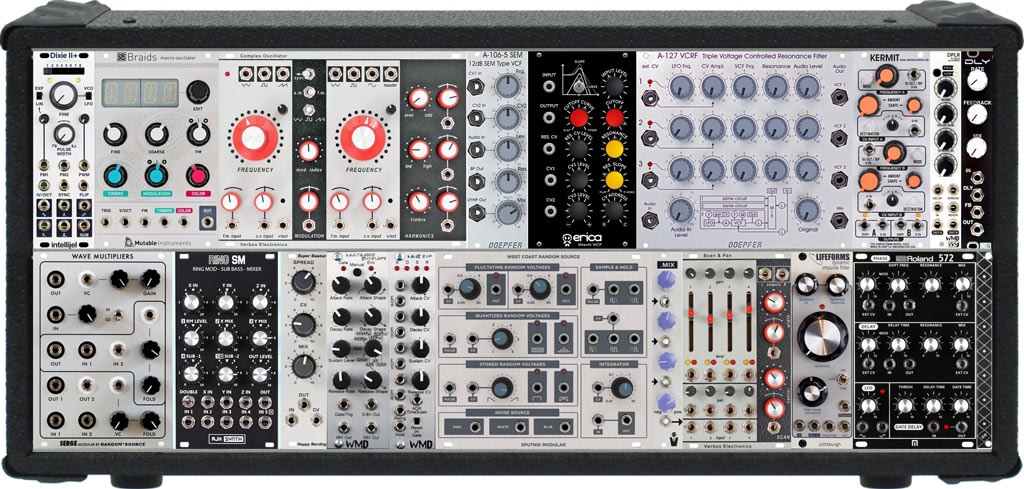How I plan to help you master your modular system, going forward from here.
I created the original Learning Modular Synthesis course for those who were complete beginners to the world of modular synthesis (although I’ve received lots of nice feedback from even experienced users who said it helped clarify numerous concepts for them). I then created a couple of courses aimed at those coming to modular through soft synths (i.e. Arturia Modular V), or starting out with a semi-modular synth (i.e. the Moog Mother-32).
The next question became: How do I help users reach the next level? The answer is the Eurorack Expansion Project. The idea is you have a nice core system, and want to know how to intelligently expand it – particularly if you interested in a specific technique or are after a certain sound. I’m tackling this in two parts: an online course, and a weekly series.
 Learning Modular Synthesis: Eurorack Expansion has grown from its initial size of 77 movies and nearly 7 hours, to nearly 200 movies. It starts by discussing the important utility or “glue” modules you will need to get the most out of new modules you add, and then initially demonstrates 3 very different modules each in the major categories such as oscillators, filters, modulation sources, and more. Click this link to see the full course description, the introductory movie, and a table of contents of which modules and techniques are covered. The supporting modules used for this case are described in detail here.
Learning Modular Synthesis: Eurorack Expansion has grown from its initial size of 77 movies and nearly 7 hours, to nearly 200 movies. It starts by discussing the important utility or “glue” modules you will need to get the most out of new modules you add, and then initially demonstrates 3 very different modules each in the major categories such as oscillators, filters, modulation sources, and more. Click this link to see the full course description, the introductory movie, and a table of contents of which modules and techniques are covered. The supporting modules used for this case are described in detail here.
 Further Eurorack Expansion Project movies expand the online course by covering new modules beyond the scope of the original course. Each module will have an “overview” movie that will go over its connections and controls, and demonstrate the most common sounds it makes possible. An average of 1-3 additional movies will then go into greater detail on how the module works, and what synthesis tricks and techniques it makes possible. Quite often I use these to go beyond a specific module and dive into general synthesis subjects such as linear versus exponential control, different types of saturation, mixing waveforms and filter outputs to create more complex sounds, and more.
Further Eurorack Expansion Project movies expand the online course by covering new modules beyond the scope of the original course. Each module will have an “overview” movie that will go over its connections and controls, and demonstrate the most common sounds it makes possible. An average of 1-3 additional movies will then go into greater detail on how the module works, and what synthesis tricks and techniques it makes possible. Quite often I use these to go beyond a specific module and dive into general synthesis subjects such as linear versus exponential control, different types of saturation, mixing waveforms and filter outputs to create more complex sounds, and more.
 Each module’s “overview” movie will be available to everyone for free through the Learning Modular YouTube channel. Look for them – as well as the additional movies for about half the modules – in the Eurorack Expansion playlist on YouTube. The additional movies for the rest of the modules will be available exclusively to members of the Learning Modular Patreon Tribe.
Each module’s “overview” movie will be available to everyone for free through the Learning Modular YouTube channel. Look for them – as well as the additional movies for about half the modules – in the Eurorack Expansion playlist on YouTube. The additional movies for the rest of the modules will be available exclusively to members of the Learning Modular Patreon Tribe.
Learning Modular Patreon supporters from the $5/month level on up also get access to the Eurorack Expansion course, as well as exclusive access to blog posts written around each movie – often with additional information and tips beyond what’s in the videos. They also help decide which movies are released next; as things progress, I’ll actually be buying and reviewing modules based on their requests!
Don’t worry – I’ll continue to add articles of general interest to modular users to this web site, and expand the Glossary as you suggest terms. Learning Modular Patreon supporters as well as email list subscribers (sign up at the bottom of the home page) will also see additional posts from month to month. But the Eurorack Expansion Project will be my main focus for the next couple of years – and I’m really looking forward to the journey.


You should launch a parallel project called “The Eurorack Reduction Project,” showcasing highly functional small rigs.
That’s a large part of the reason I restrict my video system to 2 rows x 84hp, instead of using my large personal system – I don’t want to insinuate that you NEED a large system to make cool sounds.